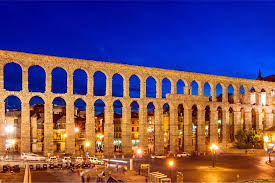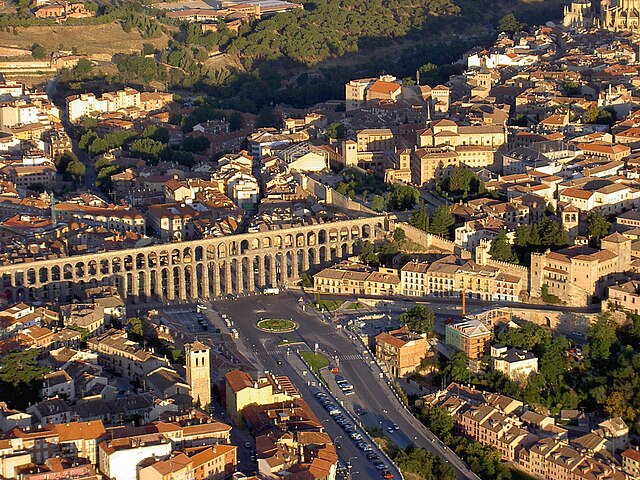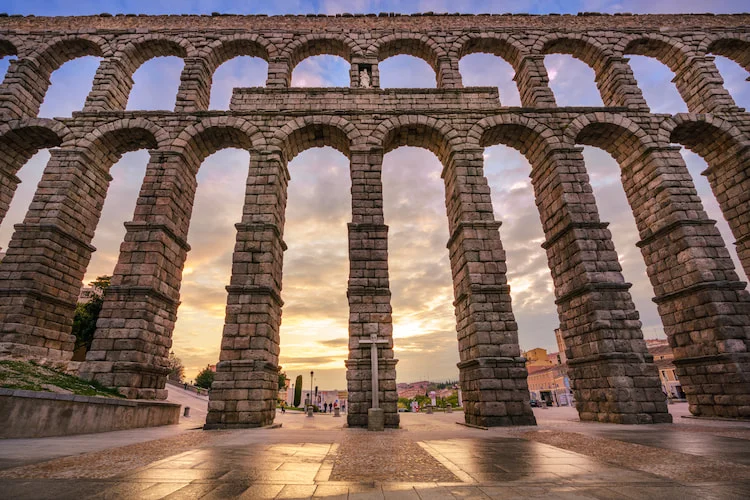Table of Contents
Toggle🌟 A Monument that Defies Time
Standing proudly in the heart of Segovia, the Aqueduct of Segovia is one of the greatest engineering achievements of the ancient Roman Empire. Built nearly two thousand years ago, this monumental structure remains astonishingly intact — a silent witness to Spain’s long and layered history. The aqueduct isn’t just a piece of stonework; it’s a symbol of Segovia’s soul, blending Roman precision with Spanish endurance.
When you first walk through Plaza del Azoguejo and see its massive arches rise against the blue Castilian sky, you instantly understand why this landmark continues to inspire awe among travelers, historians, and architects alike.
🏗️ The Engineering Marvel of Rome in Spain
Constructed around the 1st century AD, during the reigns of Emperor Domitian or Trajan, the Aqueduct of Segovia was built to transport water from the Frío River, nearly 17 kilometers away, into the city.
What makes it truly remarkable is that it was constructed without mortar — the granite blocks fit together with such precision that the structure has survived earthquakes, wars, and centuries of change.
The aqueduct stretches over 800 meters through the city, with its most famous section boasting 167 arches, some rising more than 28 meters high. This feat of ancient engineering supplied water to the Alcázar, public fountains, and baths — a lifeline that sustained Segovia for almost two millennia.
🏛️ A Living Legacy: History and Preservation

The aqueduct’s history mirrors that of Spain itself. During the Middle Ages, parts of the structure were restored by monarchs who recognized its importance. In the 15th century, Queen Isabella I ordered major repairs after Moorish invasions damaged parts of the arches.
In 1985, UNESCO declared the Aqueduct of Segovia a World Heritage Site, acknowledging its exceptional preservation and cultural significance. Today, the aqueduct stands not only as a relic of the Roman Empire but also as a symbol of Spain’s commitment to safeguarding its past
🏞️ Visiting the Aqueduct: What to See and Do
Visiting the Aqueduct of Segovia is an unforgettable experience that connects history, architecture, and culture. Here’s how to make the most of your visit:
📍 Best Viewing Points
Plaza del Azoguejo: The most iconic view, where the aqueduct towers dramatically over the square.
Mirador de la Canaleja: Offers a panoramic perspective ideal for photography.
Postigo del Consuelo Arch: A quieter spot to appreciate the details of Roman craftsmanship.
⏰ Best Time to Visit
Early morning or late afternoon — the golden light enhances the warm tones of the granite, making for breathtaking photos.
🚶 Walking Route
Follow the aqueduct’s course uphill to the Mirador del Diablo, where you can see how it once carried water into Segovia’s old town. Continue toward the Cathedral and Alcázar, both within walking distance.
🍽️ Nearby Experiences
After exploring, enjoy a traditional meal at one of Segovia’s famous restaurants — especially the legendary Cochinillo Asado (roast suckling pig), a local delicacy that perfectly complements the city’s historic charm

🕯️ Legends and Cultural Significance
Local folklore adds a touch of magic to the monument. According to one legend, a young servant girl made a pact with the devil — offering her soul if he could build an aqueduct to bring water before dawn. When morning came, only one stone was missing, saving her soul and leaving a small gap in the structure that visitors still point out today.
This fusion of myth and history gives the Aqueduct of Segovia a unique place in Spanish culture — it’s not just a monument but a living story passed down through generations
📸 Photography Tips
Capture the arches from below at midday for dramatic symmetry.
Try night photography — the soft lighting highlights its ancient texture.
Use the Mirador de la Canaleja for panoramic skyline shots
🌍 How to Get There
Segovia is only about 90 km from Madrid, making the aqueduct one of the most popular day trips from the capital.
🚆 By Train: AVE high-speed trains take about 30 minutes from Madrid-Chamartín to Segovia-Guiomar.
🚌 By Bus: Regular buses run from Madrid’s Moncloa Station (1h 15m).
🚗 By Car: A scenic 1-hour drive through the Castilian countryside.
Once you arrive, the aqueduct is impossible to miss — it literally welcomes you to the city
🕰️ Practical Information
Entrance Fee: Free (it’s a public monument).
Accessibility: The main square and viewpoints are accessible to all.
Nearby Attractions: Segovia Cathedral, Alcázar of Segovia, Casa de los Picos, Jewish Quarter
🌄 Where History Meets Eternity
The Aqueduct of Segovia is far more than an ancient water channel — it’s a masterpiece that unites eras, empires, and generations. From the genius of Roman engineering to the legends of Castilian folklore, it embodies the spirit of Spain itself: resilient, timeless, and beautiful beyond measure.
Whether you’re an architecture lover, a history enthusiast, or simply a curious traveler, this extraordinary monument invites you to pause and imagine the countless lives it has witnessed. Standing beneath its arches, you don’t just see history — you feel it.


